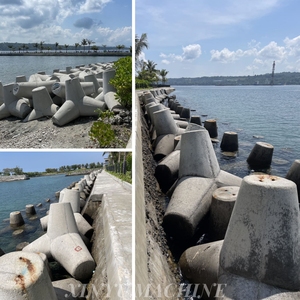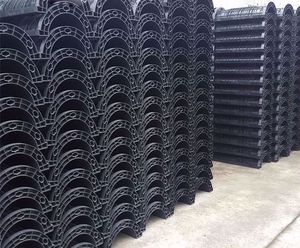
All categories
Featured selections
Trade Assurance
Buyer Central
Help Center
Get the app
Become a supplier

(1227 products available)














































A circular concrete column formwork is a cylindrical mold used to shape and support concrete columns until they harden. There are two main types:
Traditional Formwork
Metal or wooden strips are assembled into a circular form. This requires skilled labor and can take a lot of time.
Slip Forms
These are continuous, adjustable forms moved upward as the concrete sets. They're mainly used for circular columns in tall structures, like skyscrapers. Slip forms enable quick column construction and maintain uniformity across all columns. However, precise planning and continuous concrete supply are necessary for their effective use.
Jump Forms
These forms are similar to slip forms, but they move vertically in sections after each completed section. They are primarily used for circular concrete columns in high-rise buildings and structures. Jump forms allow for the construction of multiple levels of circular columns simultaneously. Still, they require a well-organized construction schedule and appropriate machinery for efficient operation.
Spiral Forms
These are special types of forms used to create concrete columns with a spiral or helical shape. They can be adjusted to different diameters and spiral configurations based on the specific project requirements. Spiral forms are mainly used in constructing parking garages, bridges, and other structures requiring spiral columns. They facilitate the creation of unique architectural designs involving spiral-shaped concrete columns.
Plastic and Metal Forms
These prefabricated circular forms are made from either high-density polyethylene plastic or metal (usually aluminum or steel). They are used when the columns are of a small diameter and height. They are also used when speed and efficiency are paramount; for instance, in the construction of residential buildings and small bridges. They allow for quick setup and takedown, resulting in reduced labor costs and time on the project. Additionally, they result in a smooth finish on the concrete column.
Fabric-Reinforced Forms
These forms are made from high-strength, concrete-impregnated fabric reinforced with various materials, including resins and steel. They are used for large-diameter columns where a lightweight, high-strength form is needed. Fabric-reinforced forms are generally more cost-effective compared to traditional forms. They are also easy to transport and set up, which saves time and reduces labor costs.
Reusable and Cost-Effectiveness:
Metal and plastic are the primary materials used to build circular concrete column formwork. These materials are very strong and can withstand repeated use without breaking or deteriorating.
Because the column form can be used multiple times on different construction projects, it helps save money. The need to buy new column forms for every project is reduced, lowering overall formwork costs.
Enhanced Strength and Stability:
Circular concrete column formworks are constructed using sturdy materials like steel and aluminum. These materials ensure that the column forms remain stable and maintain their shape when concrete is poured.
The stability and strength of circular column forms allow for the creation of straight and smooth concrete columns. This results in columns that are structurally strong and attractive when the concrete sets and hardens.
Improved Surface Finish:
Many types of circular concrete column formworks have smooth surfaces on the inside. This helps produce concrete columns with smooth surfaces that look good.
Some formworks have features that help the concrete easily release when it's completely set. This allows for the easy removal of the concrete from the formwork without damaging the column or leaving marks.
Versatility:
This formwork comes in various sizes and diameters, allowing it to accommodate different column dimensions. Whether the column needs to be thin, wide, tall, or short, there's a suitable circular formwork.
The formworks for circular columns can be adjusted to create columns of different heights. This flexibility allows builders to make columns that fit a building's design plans, whether they are short or tall.
Ease of Assembly and Disassembly:
Circular column formworks are usually lightweight. This makes it easy for construction workers to lift, move, and position them when building circular concrete columns.
The design of circular column formworks allows for quick and simple assembly. They often have parts that fit together securely, allowing workers to build the form in a short amount of time.
Circular concrete column formwork is used in various industries, including construction, infrastructure, and engineering projects. Here are some common use scenarios:
Building Construction:
Formwork is extensively used in building construction projects such as residential, commercial, and industrial buildings. It is used to create concrete columns that support building structures like bridges, overpasses, and viaducts. Its formwork provides a strong and stable base for the construction of columns in building projects.
Infrastructure Projects:
Infrastructure projects like parking garages, stadiums, and arenas use column formwork to create concrete columns for structural support. It is also used in the construction of water treatment plants, power plants, and industrial facilities. Circular column formworks are ideal for large-scale construction projects like high-rise buildings and skyscrapers.
Bridges and Elevated Structures:
Column formwork is used to construct concrete columns for bridges, especially in the piers and abutments areas. The formwork provides the necessary shape and support for the curing of concrete in these areas. Elevated structures such as flyovers, road underpasses, and railways also utilize column formwork for the construction of support columns.
Tunnels and Underground Construction:
In some cases, column formwork may be used in tunnel construction to create support columns. It is especially utilized in underground construction projects that require vertical or inclined columns for structural support.
Heavy Machinery and Equipment Support:
Column formwork is used to create concrete columns to support heavy machinery, equipment, and industrial processes in factories, warehouses, and industrial facilities.
Infrastructure Rehabilitation and Retrofits:
Circular column formwork can be used in infrastructure projects to create new support columns or strengthen existing ones during rehabilitation or retrofitting processes. This is particularly useful in improving the structural integrity and load-bearing capacity of aging infrastructure.
Choosing the right circular concrete column formwork involves considering various factors to ensure optimal performance and desired structural outcomes. Here are some key points to keep in mind:
Column Diameter and Height
The diameter and height of the columns should be determined before choosing the formwork. This will help decide whether to use flexible or adjustable formwork or fixed-size formwork.
Concrete Mix and Pouring Conditions
The selected concrete mix design should be compatible with the chosen formwork materials. Consider the pouring conditions, such as temperature and weather. Adverse weather conditions may require insulated or heated formwork.
Project Timeline
If the project has a tight timeline, consider using quick-assembly and disassembly formwork systems. This can significantly reduce labor and time costs on-site.
Column Load-Bearing Capacity
The load-bearing capacity of the column should be established. This will determine the concrete mix design and column dimensions. It may also influence the choice of formwork system.
Budget Constraints
There are various formwork systems available at different price points. Weigh the initial costs against the long-term benefits. For instance, reusable formwork may have a higher upfront cost but can be more economical for multiple uses.
Labor Skills and Availability
The level of expertise of the available labor should be considered. Complex formwork systems may require skilled labor for assembly and disassembly, while simpler systems can be handled by less experienced workers.
Environmental Considerations
When choosing formwork, consider the environmental impact. Opt for suppliers who practice sustainable forestry or use recycled materials. This is more favorable to the environment and meets the growing demand for sustainable construction practices.
Regulatory Requirements
Construction projects are subject to local building codes and regulations. Ensure the selected formwork complies with these standards to avoid delays and penalties.
Q1: How can the formwork be reused?
A1: The formwork can be reused to lower construction costs by minimizing circular concrete column formwork for sale. To ensure successful reuse, the initial concrete surface should be smooth, and structural integrity should be intact. Proper cleaning and maintenance practices should also be implemented.
Q2: What is the lead time for order?
A2: The lead time for order depends on the size and quantity of the ordered formwork. For small orders, the lead time can take 7 to 12 days, while large orders take 13 to 30 days. It is worth noting that the lead time is not fixed, and it varies depending on other factors.
Q3: Is it possible to customize the formwork?
A3: Yes, it is possible to customize the formwork. This can be done by providing precise specifications, including desired diameter, height and any incorporated features such as climbing systems or insulation panels. Skilled engineers will design and fabricate the custom formwork.
Q4: What are the payment terms?
A4: Payment terms vary among suppliers. Some accept 30% T/T deposit and 70% T/T balance before shipping, while others accept 100% irrevocable L/C at sight. Business owners are advised to read reviews and ratings before settling on a supplier.
Q5: What are the shipping options?
A5: There are various shipping options, including sea freight and air freight. Sea freight is cost-effective and takes longer, while air freight is faster and more expensive. The choice depends on the customer's preferences, urgency and order size.